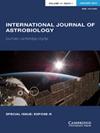Physical and chemical mechanisms that impact the detection, identification, and quantification of organic matter and the survival of microorganisms on the Martian surface – a review
IF 1
4区 物理与天体物理
Q3 ASTRONOMY & ASTROPHYSICS
引用次数: 1
Abstract
Abstract The iconic Viking Landers that landed on Mars in 1976 demonstrated that the Martian surface is an extreme place, dominated by high UV fluxes and regolith chemistry capable of oxidizing organic molecules. From follow-on missions, we have learned that Mars was much warmer and wetter in its early history, and even some areas of Mars (such as crater lakes, possibly with sustained hydrothermal activity) were habitable places (e.g. Grotzinger et al. (2014). Science (New York, N.Y.) 343; Mangold et al. (2021). Science (New York, N.Y.). However, based on the Viking results we have learnt that the search for life and its remains is challenged by abiotic breakdown and alteration of organic material. In particular, the harsh radiation climate at the Martian surface that directly and indirectly could degrade organics has been held accountable for the lack of organics in the Martian regolith. Recent work simulating wind-driven erosion of basalts under Mars-like conditions has shown that this process, comparable to UV- and ionizing radiation, produces reactive compounds, kills microbes and removes methane from the atmosphere. and thereby could equally jeopardize the success of life-seeking missions to Mars. In this review, we summarize and discuss previous work on the role of physical and chemical mechanisms that affect the persistence of organics, and their consequences for the detection of life and/or its signatures in the Martian regolith and in the atmosphere.影响火星表面有机物检测、鉴定和定量以及微生物生存的物理和化学机制——综述
摘要1976年登陆火星的标志性维京登陆者证明,火星表面是一个极端的地方,主要由高紫外线通量和能够氧化有机分子的风化层化学组成。从后续任务中,我们了解到,火星在其早期历史上要温暖潮湿得多,甚至火星的一些区域(如火山口湖,可能有持续的热液活动)也是宜居之地(例如Grotzinger等人(2014)。《科学》(纽约,纽约)343;Mangold等人(2021)。科学(纽约,纽约)。然而,根据维京人的研究结果,我们了解到,寻找生命及其遗迹受到非生物分解和有机物质变化的挑战。特别是,火星表面恶劣的辐射气候可能直接或间接降解有机物,这被认为是火星风化层缺乏有机物的原因。最近模拟类似火星条件下玄武岩风力侵蚀的工作表明,这一过程与紫外线和电离辐射相当,可以产生活性化合物,杀死微生物,并从大气中清除甲烷。从而同样可能危及火星生命探索任务的成功。在这篇综述中,我们总结并讨论了以前关于影响有机物持久性的物理和化学机制的作用,以及它们对探测火星风化层和大气中的生命和/或其特征的影响的工作。
本文章由计算机程序翻译,如有差异,请以英文原文为准。
求助全文
约1分钟内获得全文
求助全文
来源期刊

International Journal of Astrobiology
地学天文-地球科学综合
CiteScore
3.70
自引率
11.80%
发文量
45
审稿时长
>12 weeks
期刊介绍:
International Journal of Astrobiology is the peer-reviewed forum for practitioners in this exciting interdisciplinary field. Coverage includes cosmic prebiotic chemistry, planetary evolution, the search for planetary systems and habitable zones, extremophile biology and experimental simulation of extraterrestrial environments, Mars as an abode of life, life detection in our solar system and beyond, the search for extraterrestrial intelligence, the history of the science of astrobiology, as well as societal and educational aspects of astrobiology. Occasionally an issue of the journal is devoted to the keynote plenary research papers from an international meeting. A notable feature of the journal is the global distribution of its authors.
 求助内容:
求助内容: 应助结果提醒方式:
应助结果提醒方式:


